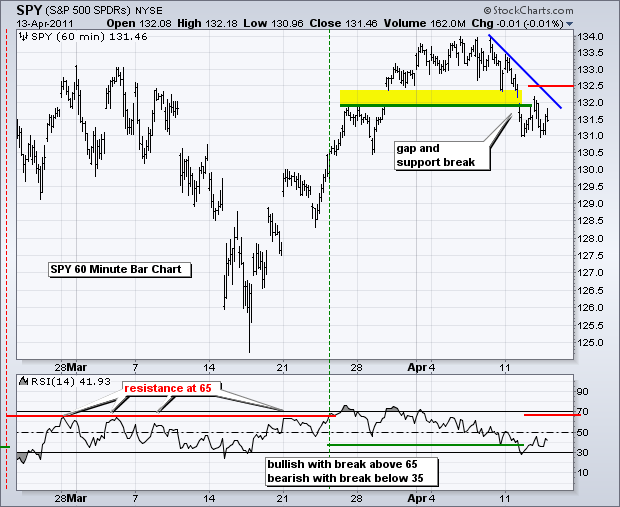The big trend on the daily chart is up as prices move from the lower left to the upper right. SPY became overbought after a big surge back to the February high and backed off this level the last four days. The ETF has actually closed lower five days in a row, which has not happened since early August. Currently, SPY is short-term oversold within an uptrend and CCI is trading near the zero line. This could give way to a bounce, but we need to watch short-term resistance on the 60-minute chart for confirmation of a short-term trend reversal.
At this point, SPY is in a short-term downtrend on the 60-minute chart. A break above resistance is needed to forge an upside reversal. The ETF broke support at 132 with a gap and this gap is largely holding. RSI also broke below 35 to turn momentum bearish. SPY opened strong on Wednesday, but failed to follow through and closed weak. This marks the second strong open-weak close day in the last four trading days. Wednesday's reaction high affirms the resistance zone just above 132. Key short-term resistance is set at 132.5 and a move above this level is needed to reverse the five day slide.

Key Economic Reports/Events:
Thu - Apr 14 - 08:30 - Jobless Claims
Thu - Apr 14 - 08:30 – Producer Price Index
Fri - Apr 15 - 08:30 – Consumer Price Index
Fri - Apr 15 - 08:30 - Empire Manufacturing Index
Fri - Apr 15 - 09:15 - Industrial Production
Fri - Apr 15 - 09:55 - Michigan Sentiment
Charts of Interest: Tuesday and Thursday in separate post.
-----------------------------------------------------------------------------
This commentary and charts-of-interest are designed to stimulate thinking. This analysis is not a recommendation to buy, sell, hold or sell short any security (stock ETF or otherwise). We all need to think for ourselves when it comes to trading our own accounts. First, it is the only way to really learn. Second, we are the only ones responsible for our decisions. Think of these charts as food for further analysis. Before making a trade, it is important to have a plan. Plan the trade and trade the plan. Among other things, this includes setting a trigger level, a target area and a stop-loss level. It is also important to plan for three possible price movements: advance, decline or sideways. Have a plan for all three scenarios BEFORE making the trade. Consider possible holding times. And finally, look at overall market conditions and sector/industry performance.

About the author:
Arthur Hill, CMT, is the Chief Technical Strategist at TrendInvestorPro.com. Focusing predominantly on US equities and ETFs, his systematic approach of identifying trend, finding signals within the trend, and setting key price levels has made him an esteemed market technician. Arthur has written articles for numerous financial publications including Barrons and Stocks & Commodities Magazine. In addition to his Chartered Market Technician (CMT) designation, he holds an MBA from the Cass Business School at City University in London.
Learn More
